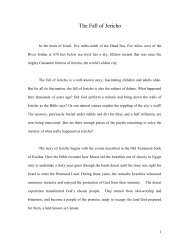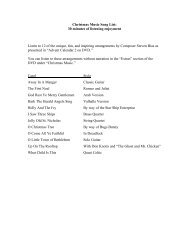Torchlighters: Augustine Leader's Guide - Vision Video
Torchlighters: Augustine Leader's Guide - Vision Video
Torchlighters: Augustine Leader's Guide - Vision Video
You also want an ePaper? Increase the reach of your titles
YUMPU automatically turns print PDFs into web optimized ePapers that Google loves.
Leader’s <strong>Guide</strong> to accompany the DVD The <strong>Torchlighters</strong>: The <strong>Augustine</strong> StoryReligionReligion in the Roman Empire was just as diverse as its peoples. Eastern religions and Judaism hadpenetrated Rome for many years and were a part of life. The Edict of Milan issued by Constantine,then emperor of the west, and Licinius, emperor of the east, in 313, gave freedom to all religions. In380 Theodosius (not yet sole emperor) and Gratian declared together that “Catholic” Christianity, asdistinguished from Arian Christianity, was the official religion of the empire.Despite the emperor’s best efforts, the ancient religion of Rome was equated with patriotism and culturewhile Christianity was decidedly non-patriotic. The aristocracy, even in <strong>Augustine</strong>’s time, wereprimarily adherents to the old religion, even if in name only. Religion identified and defined the individual,and the senate was primarily pagan. As Christian families connected to the court overshadowedthe pagan aristocratic families, they considered these upstarts an affront to their position and their traditionalstatus as upholders of all that Rome represented. After all, these families were the Romans ofRome. Any move against the religion of Rome had to be opposed.The controversy over the altar of victory epitomizes this concept of patriotism and social status. Thealtar of victory was placed at the far end of the Curia, or the Senate House in Rome. It is uncertain ifthe altar stood before the statue, or if the statue was placed upon it. As the personification of Romanvictory, the golden statue depicted a winged woman holding a palm branch in one hand and the victor’slaurel crown in the other. Octavian set up the altar in 29 BC to commemorate the defeat of Anthonyand Cleopatra at Actium. It was removed by Emperor Constantius II in 357, restored by Julian theApostate and again removed by Gratian in 382. Efforts in 384 to have it replaced, repulsed byAmbrose, continued until the Edict of 380. The usurper, Eugenius (392-394), restored it for a time, butthe altar later disappeared.<strong>Augustine</strong><strong>Augustine</strong> entered this world only briefly, from his arrival in Rome in 383 to his departure in 390.During that time he was occupied with teaching and studying. He also served as Public Orator inMilan, where he struggled with faith, yet did not want to give up worldly pleasures. Finally, in 386,<strong>Augustine</strong> had his now famous encounter with Scripture and embraced Christianity. Following baptismand further study, he lived in his preferred land of North Africa, far from the conflicts of empire.Learn more about The <strong>Torchlighters</strong>: Heroes of the Faith programs at www.torchlighters.org. 18







